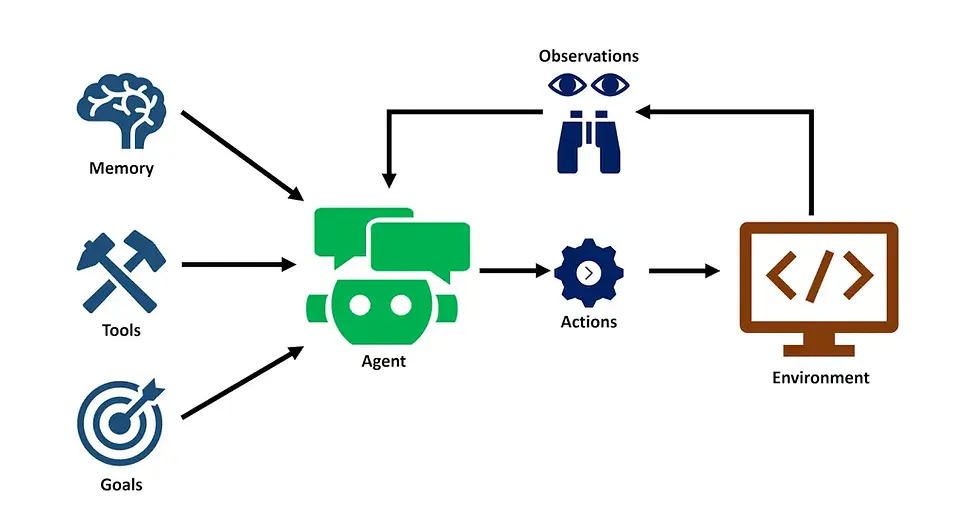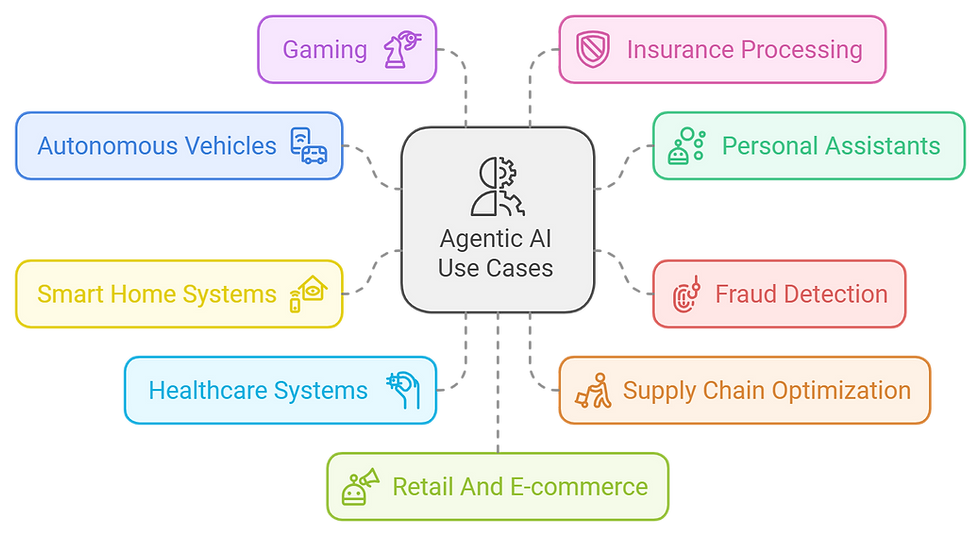Agentic AI vs Generative AI: Key Differences Explained
- Mimic Minds
- Oct 1
- 5 min read

Artificial Intelligence (AI) has become the backbone of modern innovation, transforming industries and reshaping how humans interact with technology. Among the most significant developments are Agentic AI vs Generative AI — two distinct but complementary approaches that power today’s most advanced systems.
While Generative AI creates new content when prompted, Agentic AI goes a step further by acting autonomously, setting goals, and making proactive decisions. Understanding these differences is critical for businesses, creators, and enterprises aiming to harness AI for growth, automation, and creativity.
At Mimic Minds, we integrate both approaches to build lifelike conversational avatars and AI-driven digital characters — blending Generative AI’s creativity with Agentic AI’s autonomy.
Table of Contents
What is Generative AI?

Generative AI refers to machine learning models trained on massive datasets that can generate entirely new content. This includes text, images, music, code, or even 3D designs. Popular tools such as ChatGPT, Midjourney, and DALL·E are leading examples of Generative AI at work.
Key Features of Generative AI:
Learns patterns from vast datasets using deep learning.
Generates text, visuals, code, music, or video on demand.
Operates reactively — requires a human prompt to function.
Versatile, adaptable across creative and analytical tasks.
Common Use Cases:
Marketing content, blogs, and storytelling.
Designing visuals, logos, and animations.
Rapid prototyping in software and product design.
Translating content across multiple languages.
In short: Generative AI is powerful for creative production, but it needs prompts and lacks autonomy.
Generative AI Tools and Features

Generative AI has exploded thanks to user-friendly tools that democratize creativity.
Notable tools include:
ChatGPT – Natural language content generation.
Midjourney – AI-generated art and illustrations.
DALL·E – Image generation from text prompts.
Runway ML – AI-assisted video and VFX creation.
These tools showcase how Generative AI enhances creativity but depends on user inputs to operate.
What is Agentic AI?

While Generative AI reacts to prompts, Agentic AI represents the next evolution: autonomous, goal-driven intelligence. It doesn’t just generate outputs — it sets tasks, makes decisions, and acts proactively in dynamic environments.
Key Features of Agentic AI:
Autonomy – Acts without continuous human input.
Memory & Learning – Retains context for long-term decision-making.
Planning & Strategy – Creates step-by-step approaches to achieve goals.
Proactivity – Anticipates needs rather than waiting for prompts.
Common Use Cases:
Autonomous digital assistants (e.g., AI that schedules your week).
Robotics and smart automation.
Workflow optimization in enterprises.
Personalized customer engagement at scale.
In short: Agentic AI isn’t about creating content — it’s about decision-making, planning, and acting independently.
Agentic AI vs Generative AI: Key Differences
The table below highlights the differences between the two approaches:
Feature | Generative AI | Agentic AI |
Primary Function | Creates content | Makes decisions & takes actions |
Initiation | Reactive | Proactive |
Data Dependency | Needs large datasets to generate results | Relies on environment interaction, planning |
Autonomy | Low – depends on prompts | High – can operate independently |
Memory & Learning | Typically lacks long-term memory | Maintains memory for context-based learning |
Example | ChatGPT generating a poem | An AI agent scheduling your week based on priorities |
Implications:
Use generative when speed of ideation and content diversity is the priority.
Use agentic when you want autonomous workflows with measurable outcomes.
Combine both to get expressive communication plus dependable execution.
Helpful context: If you are comparing conversational systems, review Conversational AI vs Chatbot for how reactive chat fits next to proactive agents.
Mimic Minds: Bridging Generative and Agentic AI

At Mimic Minds, we combine both Agentic AI and Generative AI to create lifelike digital characters and avatars. Unlike traditional solutions, our AI avatars are not limited to reactive interactions. They can:
Engage in conversational AI seamlessly — see our article on Conversational AI vs Chatbot for context.
Make decisions proactively—our avatars can suggest next steps without waiting for commands.
Evolve memory-based personalities that adapt across sessions.
Deploy in AI in healthcare contexts, AI in HR systems, or conversational AI in education settings.
Participate in immersive mediums — see The Future of Digital Interaction: Conversational AI Avatars for inspiration: link.
Our AI characters — each with unique personalities, voices, and expertise — showcase the true potential of merging Agentic AI vs Generative AI into one powerful system.
Why Businesses Should Care

For businesses, understanding Agentic AI vs Generative AI is not academic—it’s strategic.
Generative AI accelerates content production and creative tasks.
Agentic AI automates decisions and workflows.
Combined, they produce immersive, autonomous systems—digital humans that can converse, decide, and act.
Industries like healthcare, HR, education, and enterprise are already leveraging avatars, AI systems, and conversational agents. For example:
In healthcare, AI avatars can assist patients or predict care paths.
In HR, autonomous agents can manage onboarding workflows.
In education, AI tutors use conversation + action to support learners (see our post on Conversational AI in Education).
This synergy is rewriting how companies engage, automate, and scale.
Benefits of Combining Agentic AI and Generative AI
The synergy between the two models delivers unmatched results.
Immersive Customer Engagement – AI avatars that create content and respond intelligently.
Scalable Automation – Proactive systems handling workflows independently.
Personalization – Memory-driven AI for tailored experiences.
Innovation – Blending creativity with autonomy for groundbreaking solutions.
One-line takeaway: Combining both systems creates AI that is creative, intelligent, and independent.
Challenges and Considerations
Adopting Agentic AI vs Generative AI also brings challenges:
Data Privacy – Handling sensitive personal or corporate data securely.
Bias & Ethics – Both AI types can inherit bias from training data.
Complexity – Agentic AI requires robust infrastructure for decision-making.
Change Management – Teams must adapt to AI-driven workflows.
Balancing creativity and autonomy with ethical considerations ensures sustainable AI adoption.
FAQs on Agentic AI vs Generative AI
Q1. What is the difference between Agentic AI vs Generative AI?
Generative AI creates new content based on prompts, while Agentic AI makes autonomous decisions and acts proactively.
Q2. Can Generative AI work without Agentic AI?
Yes, but it will always remain reactive. Without Agentic AI, it cannot act independently.
Q3. Which industries use Agentic AI vs Generative AI?
Both are used across healthcare, gaming, education, enterprise solutions, and digital human development.
Q4. Why combine them?
Together, they enable digital avatars that are both expressive and autonomous, offering unmatched user interaction.
Q5. Will Agentic AI replace Generative AI?
No. They complement each other — one creates, the other acts.
Q6. Which industries benefit most?
Healthcare, HR, education, and digital engagement are strong fits. See AI in Healthcare Industry, AI in HR, and Conversational AI in Education for deeper examples.
Conclusion
The future of AI is not about choosing between Agentic AI vs Generative AI — it’s about integrating them. While Generative AI produces creative content, Agentic AI ensures intelligent, proactive execution. Together, they redefine how brands, enterprises, and creators can interact with their audiences.
At Mimic Minds, we are pioneering this hybrid approach through our AI avatars and digital humans. By blending artistic precision, advanced AI, and real-time performance, we’re shaping the next era of human-AI interaction.
About Mimic Minds
Mimic Minds specializes in crafting lifelike conversational AI avatars and metaverse assets, utilizing cutting-edge AI and 3D technology. Mimic offers a next-generation digital human platform for personalized, photorealistic avatars that can be integrated into a wide range of digital experiences and solutions.
By combining artistic precision with technical innovation, we enable individuals and organizations to connect, communicate and engage in ways that feel natural and immersive.
For further information and in case of queries please contact Press department Mimic Minds: info@mimicminds.com.




Comments